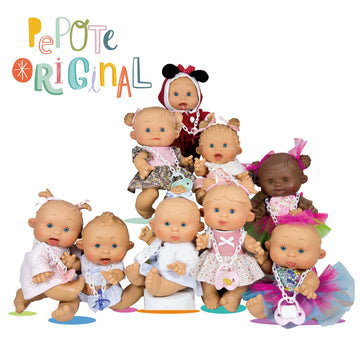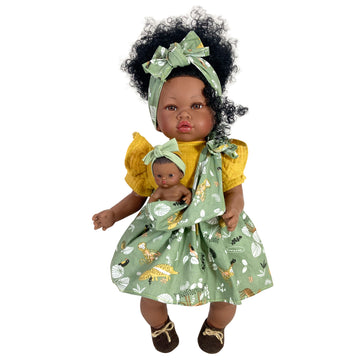Things about Dolls And Accessories
Things about Dolls And Accessories
Blog Article
Not known Details About Dolls And Accessories
Table of ContentsThe Dolls And Accessories PDFsDolls And Accessories Things To Know Before You Get ThisHow Dolls And Accessories can Save You Time, Stress, and Money.Dolls And Accessories Things To Know Before You BuyThe Best Strategy To Use For Dolls And AccessoriesThe Single Strategy To Use For Dolls And AccessoriesOur Dolls And Accessories PDFs
When dolls are included in group play, kids exercise waiting, sharing, and listening to others' concepts. Whether they're acting to be a parent, sibling, or pal, kids discover just how connections workhow to support others, fix arguments, and take care of somebody else. These early role-play experiences end up being the groundwork for healthy friendships and relationships later on in life.Duplicating calming routines with a doll (feeding, shaking, closing) can aid children really feel tranquil and safe. These calming routines educate them how to self-regulate. Taking care of a doll can make a kid feel qualified and positive - baby dolls. It provides a sense of duty and control in a globe that often feels unpredictable.
More About Dolls And Accessories
When youngsters see dolls that mirror their race, heritage, and society, it reinforces a favorable feeling of identity. Dolls also present kids to societies outside their own, constructing respectful inquisitiveness and compassion for others.
As Dr. Karyn Purvis, a leader in youngster development and trauma-informed treatment, as soon as stated: This powerful quote highlights just how play isn't just funit's how children discover best. The mind wires itself with rep. When a youngster is involved, happy, and mentally linked to an activitylike doll playthe mind strengthens those links much faster and extra meaningfully.
Our Dolls And Accessories Statements

Young boys require compassion, compassion, and imagination tooand doll play uses that. Yesdolls offer something distinct. They motivate open-ended narration and emotional link in a manner few various other toys do. Dolls are commonly a child's very first "pal," assisting them practice connections, develop communication abilities, and really feel comforted. Kids develop their feeling of self from a young age.
Dolls And Accessories Fundamentals Explained
Through dolls that matter. Samantha Ong Samantha Ong is the founder of Joeydolls, a Canadian-based plaything brand on a mission to commemorate Oriental cultures with happy, comprehensive play. Influenced by her own experiences growing up without cultural representation, Samantha designs dolls that aid children really feel happy of that they are while stimulating interest and empathy in others.
Playing with dolls motivates children to talk more about others' ideas and feelings, a research study has actually located. The research recommends that playing fictional games with dolls might assist youngsters develop social skills, concept of mind and compassion.
Not known Details About Dolls And Accessories
They were also extra likely to address the dolls in the 2nd individual, speaking with them straight, whereas the characters on the computer screen they tended to refer to in the third person. No difference was observed in between children and ladies."Inner state language can indicate that a youngster is considering various other individuals's thoughts and emotions while playing with dolls," stated Gerson.
And that they see language use in this regard is good confirmation of the theory."Mardell included that the searchings for ought to use to any kind of role-play plaything, rather than being particular to Barbies."Children commonly begin to show indicators of interior state language around the age of four.
Dolls And Accessories - An Overview
"It comes to be important for making and maintaining relationships, and just how they pick why not try these out up from their educators, and moms and dads."The research additionally found that the children had actually boosted brain activity in the posterior remarkable temporal sulcus (pSTS) region when they spoke as though their dolls had thoughts and feelings. The pSTS region is believed to be entailed in the advancement of social and emotional processing skills.
Youth is not a fixed life phase; indeed, the definition, definition and understanding of youth are all subject to alteration. By the nineteenth century among one of the most extensive modifications was the value put on permitting youngsters to experience "the carefree joys" of youth with playtime tasks. Play was currently considered to be an important element of a great childhood years.
In order to totally comprehend the definition of play, one should also understand the importance of the doll. Nevertheless, dolls are far more than toys made to delight young ladies. During the nineteenth century proper playtime activities were selected to advertise intellectual, physical or psychological growth. Dolls were especially prominent due to the fact that they were assumed to promote and nurture womanly qualities such as generosity, caring and concern.
All About Dolls And Accessories

It is only through archaeological examinations that researchers can want to reveal and record the full range of play experiences. Chronicling these experiences, and specifically the duty of dolls, is essential for offering a much more complete picture of youth throughout the nineteenth century. Alarcn, Sara E - high end dolls., "Kid's Play: The Duty of Dolls in 19th Century Childhood Years" (2007 )
Report this page